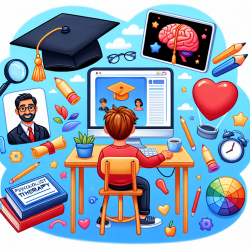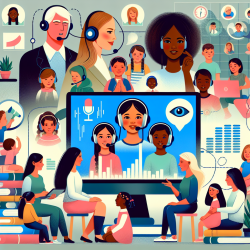Curiosity is the engine of achievement, and as mental health professionals working within the educational system, our innate curiosity drives us to seek out the most effective ways to support the children in our care. The theme of virtual therapy is not just a trend; it is an evolution in our field, reshaping the landscape of how services like speech therapy are delivered in schools. The detailed nature of this blog aims to not only inform but also inspire you to see the potential that online therapy services hold for your practice and the kids you serve.
Teletherapy, a term that has been gaining momentum over the past few years, is now at the forefront of educational and therapeutic discussions. The digital transformation has finally reached the therapy room, bringing with it a host of benefits and challenges that are worth exploring. As mental health professionals, it's crucial to stay abreast of these developments, understanding how they can enhance our ability to provide care and support to students who need it the most.
Let's delve into the world of virtual therapy and discover how it is revolutionizing speech therapy in schools, creating new opportunities for engagement, and offering innovative solutions to age-old challenges in the field of school-based mental health.
The Rise of Virtual Therapy in Schools
Virtual therapy, or teletherapy, refers to the delivery of therapeutic services via digital communication platforms. It enables therapists to connect with students remotely, breaking down geographical barriers and making services more accessible. This is particularly beneficial for schools in rural areas or for those with limited access to qualified mental health professionals.
The integration of virtual therapy into school settings has been accelerated by the necessity of remote learning during global health crises, such as the COVID-19 pandemic. However, the benefits of online therapy services extend far beyond the constraints of emergency response. It offers a sustainable and flexible approach to providing ongoing support to students, accommodating various learning and communication styles.
Advantages of Virtual Therapy for Kids
When it comes to speech therapy in schools, virtual platforms can offer a myriad of advantages for children. Engaging kids through a medium they are often already familiar with can lead to increased motivation and participation. Interactive online tools and resources make sessions more dynamic and can be tailored to each child's interests and needs, promoting a more personalized therapy experience.
Additionally, virtual therapy can often lead to improved attendance rates, as it eliminates the need for transportation and reduces absences due to illness or other conflicts. This consistency is crucial for progress in any therapeutic program, particularly in speech therapy, where regular practice and reinforcement are key.
For children with social anxieties or those who are more reserved, the virtual space can feel less intimidating than face-to-face interactions. It provides a safe environment where they can express themselves more freely, which is essential for effective speech therapy.
How Mental Health Professionals Can Embrace Virtual Therapy
As mental health professionals in schools, embracing virtual therapy requires an open mind and a willingness to adapt. It involves becoming proficient with the technology and platforms used to deliver services and developing new strategies for engaging students online.
It's important to ensure that the virtual therapy environment is secure and compliant with privacy regulations, such as the Health Insurance Portability and Accountability Act (HIPAA) in the United States. Confidentiality is just as critical online as it is in person, and using secure, encrypted platforms designed for teletherapy is essential.
Professionals should also consider the importance of building rapport with students in a virtual setting. This can be achieved through consistent routines, clear communication, and the use of visual and interactive elements to create a welcoming online space. Flexibility and creativity are key when adapting traditional therapy activities to the virtual format.
Challenges and Considerations
While virtual therapy presents many opportunities, it also comes with its own set of challenges. Not all students will have access to the necessary technology or a stable internet connection at home, which can create disparities in service delivery. Schools and therapy providers must work together to identify and address these issues, ensuring equity in access to virtual therapy services.
Another consideration is the training and support needed for both therapists and educators in the use of teletherapy platforms and tools. Professional development in this area is crucial for the successful implementation and sustainability of virtual therapy programs.
Furthermore, engaging parents and caregivers in the process is vital. They play an integral role in supporting their children's therapy outside of school hours, and their involvement can greatly enhance the effectiveness of virtual therapy. Clear communication and resources for parents can help them become active participants in their child's therapeutic journey.
Case Studies and Success Stories
There are numerous success stories that highlight the positive impact of virtual therapy in schools. For instance, a rural school district that struggled to find a full-time speech therapist was able to provide consistent speech therapy services to their students through an online platform. The virtual therapist worked closely with on-site educators to develop individualized plans and monitor progress, resulting in significant improvements in students' communication skills.
In another example, a student with selective mutism found her voice through virtual therapy. The online setting allowed her to communicate with her therapist via chat and interactive games initially, gradually building up her confidence to speak verbally. Over time, she was able to participate more fully in classroom activities and express herself more openly with peers.
These stories underscore the transformative potential of virtual therapy in schools and its ability to meet the diverse needs of students.
Looking Ahead: The Future of Virtual Therapy in Schools
The future of virtual therapy in schools is bright. As technology continues to advance, we can expect even more innovative tools and approaches to emerge, further enhancing the delivery of speech therapy and other mental health services.
Artificial intelligence (AI) and machine learning may soon play a role in personalizing therapy programs, while virtual and augmented reality could offer immersive experiences that simulate real-life communication challenges and social interactions. The possibilities are endless, and as mental health professionals, we have a front-row seat to this exciting evolution.
It is our responsibility to remain curious and informed, to embrace the changes that come with virtual therapy, and to continue advocating for the resources and support necessary to make these services accessible to all students. By doing so, we can ensure that every child has the opportunity to thrive, both academically and emotionally, in the ever-evolving landscape of school-based mental health.
Inspired to Act
As you reflect on the information presented in this blog, allow yourself to feel inspired. Inspired to explore the possibilities of virtual therapy in your own practice, to innovate and adapt, and to make a lasting impact on the lives of the kids you serve. The journey of integrating virtual therapy into schools is one that promises to enrich the therapeutic experience for both practitioners and students alike.
Let your curiosity lead the way as you venture into the realm of online therapy services. With each step, you are not only shaping the future of mental health in schools but also ensuring that every child has access to the care and support they need to succeed. The future is now, and it is virtual.










